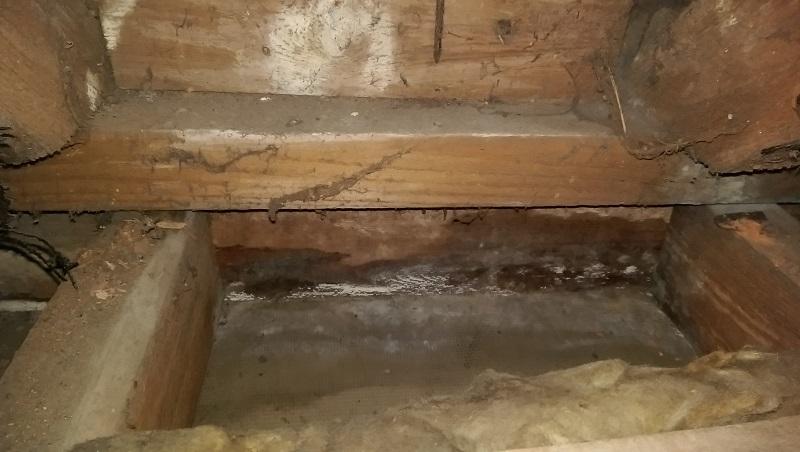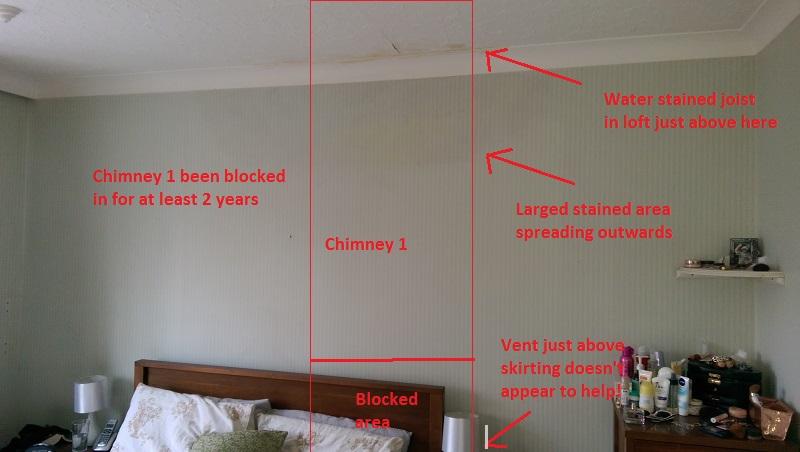Hi all,
Got a problem with the chimneys in our 1930's house. Both upstairs bedroom chimneys.
Chimney 1 was already blocked off and vented when we moved in about 2 years ago. It had some signs of damp at the time which were gradually getting worse. The roof was shot anyway so we had that fully replaced. Both chimneys were repointed, reflashed and capped at the same time. We thought that would sort the damp but if anything it's accelerated and gotten a lot worse.
Chimney 2 was open(ish) when we moved in. It had a poorly fitted victorian fireplace with concrete and bricks lumped in all around it so I can't imagine the airflow was great. We blocked this one in a couple of months ago. I always intended to vent it but kept putting it off (stupid I know) and now this one is starting to show signs of damp too (doh!)
Been reading around and I gather this is a common issue in pre-60's houses due to the way the chimneys are lined. All seems a bit technical but I gather the issue is around salts allowing water to permeate through the bricks. Just went up in the loft and low and behold, there's salt on the back of the ceiling plasterboards and joists.
So, what to do?! Yes I could/should/will vent chimney 2, but chimney 1 is really bad and getting worse and it ALREADY has a vent! So I can't be confident this will fully sort the problem on chimney 2 and I've no idea what to do about chimney 1 (already vented).
As I say both chimneys have been completely overhauled (flashing/pointing) and are capped, so I'm really not sure what else to do about this short of reopening both the fireplaces! But then I gather once the water has got through you're stuffed, so maybe opening them back wouldn't help either?!
Only thing I can think is it's mish mash of caps up there, think we've got a couple of pepperpots and the others are just curved roof tiles I think.
Anyway, apologies for the war and peace, but just wanted to get all the details across in case anyone can shed some much needed wisdom on this!
Thanks in advance,
Rob
Got a problem with the chimneys in our 1930's house. Both upstairs bedroom chimneys.
Chimney 1 was already blocked off and vented when we moved in about 2 years ago. It had some signs of damp at the time which were gradually getting worse. The roof was shot anyway so we had that fully replaced. Both chimneys were repointed, reflashed and capped at the same time. We thought that would sort the damp but if anything it's accelerated and gotten a lot worse.
Chimney 2 was open(ish) when we moved in. It had a poorly fitted victorian fireplace with concrete and bricks lumped in all around it so I can't imagine the airflow was great. We blocked this one in a couple of months ago. I always intended to vent it but kept putting it off (stupid I know) and now this one is starting to show signs of damp too (doh!)
Been reading around and I gather this is a common issue in pre-60's houses due to the way the chimneys are lined. All seems a bit technical but I gather the issue is around salts allowing water to permeate through the bricks. Just went up in the loft and low and behold, there's salt on the back of the ceiling plasterboards and joists.
So, what to do?! Yes I could/should/will vent chimney 2, but chimney 1 is really bad and getting worse and it ALREADY has a vent! So I can't be confident this will fully sort the problem on chimney 2 and I've no idea what to do about chimney 1 (already vented).
As I say both chimneys have been completely overhauled (flashing/pointing) and are capped, so I'm really not sure what else to do about this short of reopening both the fireplaces! But then I gather once the water has got through you're stuffed, so maybe opening them back wouldn't help either?!
Only thing I can think is it's mish mash of caps up there, think we've got a couple of pepperpots and the others are just curved roof tiles I think.
Anyway, apologies for the war and peace, but just wanted to get all the details across in case anyone can shed some much needed wisdom on this!
Thanks in advance,
Rob





